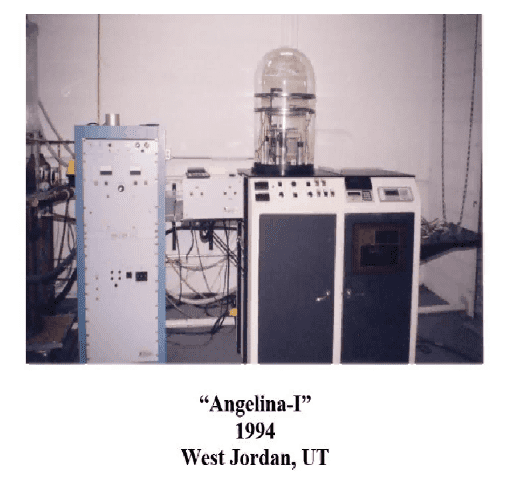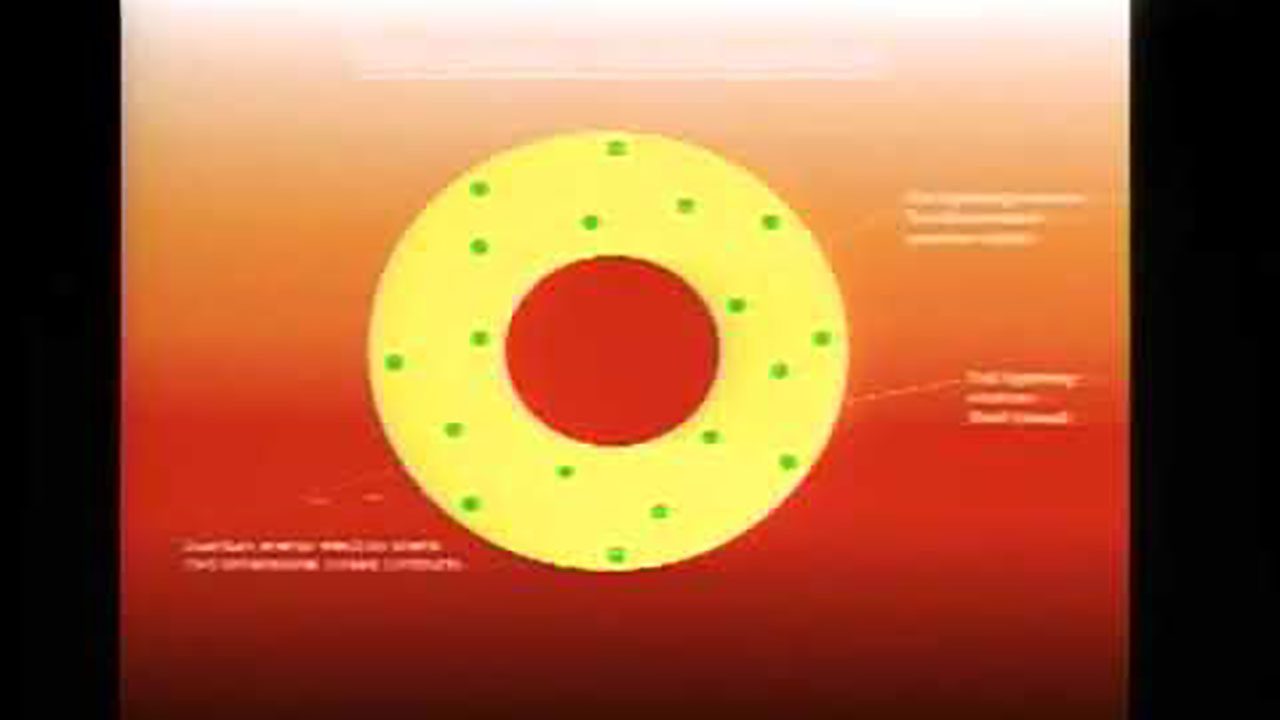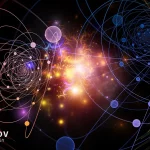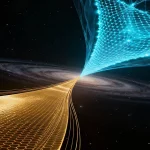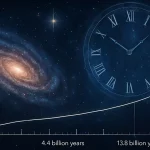Abstract
We introduce an innovative reformulation of physics, which we term General Quantum Mechanics (GQM). This groundbreaking theory seamlessly integrates the foundational principles of quantum mechanics, the nature of gravitation, and the expansive field of cosmology within a cohesive framework of elastic vacuum. At the heart of GQM lies a fascinating duality involving two interacting manifolds: the Electron Matter Universe, characterized as a three-dimensional space (3D), and the Proton Matter Universe, represented in two dimensions (2D). Together, these realms create a richly structured continuum that underpins our understanding of the universe.
In this framework, gravitation and inertia are not merely byproducts of the curvature of spacetime, as traditionally posited, but rather emerge as dynamic elastic reactions of this continuum. From the interplay between electrons and protons, we derive two pivotal quantum accelerations—denoted as a0,e and a0,p. Remarkably, these constants resonate with observed anomalies in astrophysical phenomena, such as the perplexing rotation curves of galaxies and the intriguing Pioneer anomaly. Notably, this theoretical approach does so without necessitating the introduction of dark matter or dark energy.
In light of these revelations, we propose a series of meticulous laboratory experiments alongside thoughtful astrophysical reanalyses aimed at rigorously testing this framework. Such endeavors hold the potential to either validate or challenge the tenets of General Quantum Mechanics, paving the way for a deeper understanding of the universe’s fundamental workings.
1. Introduction
- GR and QFT are successful but incomplete. There are a few unresolved problems that GGM resolves with a glance:
- Dark matter and dark energy are fundamental components of cosmological models, significantly influencing the dynamics and expansion of the universe. Despite their elusive nature and the inability to detect them directly through electromagnetic radiation, their presence is inferred from gravitational effects and the large-scale structure of the cosmos. Their properties and interactions remain critical to our understanding of cosmic evolution and the ultimate fate of the universe.
- Relativity fundamentally challenges the traditional concept of absolute reference frames, reshaping our understanding of space and time. However, even within this groundbreaking theoretical framework, a range of discrepancies and anomalies continue to emerge, prompting ongoing exploration and debate among physicists. These unresolved issues hint at deeper complexities within the fabric of the universe, inviting inquiry into the very nature of reality itself.
- MOND introduces a foundational scale for acceleration, a concept that aims to enhance our understanding of gravitational phenomena in the universe. However, it falls short of offering a thorough and rigorous derivation to support the formulation of this scale, leaving some questions about its theoretical underpinnings.
- Dark matter and dark energy are fundamental components of cosmological models, significantly influencing the dynamics and expansion of the universe. Despite their elusive nature and the inability to detect them directly through electromagnetic radiation, their presence is inferred from gravitational effects and the large-scale structure of the cosmos. Their properties and interactions remain critical to our understanding of cosmic evolution and the ultimate fate of the universe.
- GQM addresses these by:
- Reexamining gravitational phenomena by exploring the intricate principles of vacuum elasticity theory, which offers a fresh perspective on the fabric of spacetime and its dynamic interactions.
- Presenting a groundbreaking approach with dual acceleration constants, meticulously derived from essential parameters of charge and mass. This innovative framework deepens our understanding of the intricate relationships governing physical phenomena, revealing insights into the fundamental forces at play.
- Enhancing the observer principle to include a Living Observer, where terrestrial life is not merely an observer but a vital cornerstone in the vast cosmic landscape. This perspective emphasizes the significance of Earth’s diverse biological existence as a reference point for understanding the universe, intertwining life and consciousness with the fabric of reality itself.
- Reexamining gravitational phenomena by exploring the intricate principles of vacuum elasticity theory, which offers a fresh perspective on the fabric of spacetime and its dynamic interactions.
2. Elastic Vacuum Gravitation
2.1 Conceptual Basis
- The vacuum can be envisioned as an intricate elastic medium, a malleable canvas that responds dynamically to the presence of mass. As objects interact with this continuous expanse, they create ripples and disturbances, initiating a series of perturbations that propagate through the fabric of space. These disruptions give rise to restoring forces, which manifest themselves as the gravitational effects that we experience. In this way, the once-invisible vacuum becomes a vibrant arena of interaction, where the very essence of mass shapes the curvature of the universe, influencing the paths and behaviors of celestial bodies.
- Inertia is the tendency of an object to resist changes in its state of motion, presenting a significant barrier when one attempts to move it through a specific medium. This resistance, often felt as a heavy burden, can make the task of displacing the object feel laborious and challenging, as it stubbornly clings to its current position. Whether it’s a hefty boulder resting on solid ground or a compact piece of furniture wedged into place, inertia embodies the fundamental principle that matter prefers to maintain its existing motion—or lack thereof—until a sufficient force is applied to overcome this intrinsic reluctance.
2.2 Fundamental Equations
Let σ be stress, ϵ strain, and E effective modulus:
Balance of forces:
Recover Newton’s law in the weak-field limit:
But in GQM, G is emergent from continuum properties:
3. Dual Universes: Electron and Proton Matter
- The universe can be conceptualized as comprising two distinct yet interconnected manifolds, each representing a different aspect of reality. One manifold may symbolize the observable universe, characterized by its physical dimensions, cosmic structures, and all known matter and energy. The other manifold might represent the underlying mathematical framework or the abstract dimensions that govern the laws of physics. Together, these two manifolds provide a comprehensive framework for understanding the complexities and interactions within the universe, merging both physical phenomena with theoretical constructs:
- Electron Matter Universe (3D): The observable universe is primarily governed by the behavior and interactions of electrons, which play a pivotal role in the formation of atoms and molecules. These negatively charged subatomic particles not only influence chemical bonding and reactions but also significantly contribute to the electric and magnetic properties of materials. The dynamics of electrons across various energies and states are central to understanding phenomena such as conductivity, magnetism, and even the intricate workings of electronic devices. In essence, electrons are foundational to the fabric of our physical reality, shaping the structures and interactions that define the cosmos.
- Proton Matter Universe (2D): The concept of a hidden manifold plays a critical role in maintaining stability within complex systems. This manifold, often not directly observable, serves as an underlying structure that guides the dynamics and behavior of the system. By providing a stabilizing framework, it helps regulate fluctuations and disturbances, ensuring the system remains balanced and functions optimally despite external changes.
- Electron Matter Universe (3D): The observable universe is primarily governed by the behavior and interactions of electrons, which play a pivotal role in the formation of atoms and molecules. These negatively charged subatomic particles not only influence chemical bonding and reactions but also significantly contribute to the electric and magnetic properties of materials. The dynamics of electrons across various energies and states are central to understanding phenomena such as conductivity, magnetism, and even the intricate workings of electronic devices. In essence, electrons are foundational to the fabric of our physical reality, shaping the structures and interactions that define the cosmos.
- The proton can be conceptualized as a “developed electron“, but it possesses a more intricate internal structure. Unlike an electron, which is considered a fundamental particle with no known substructure, the proton is made up of three quarks—two up quarks and one down quark—bound together by the strong force, mediated by gluons. This complex arrangement gives protons their positive charge and mass, distinguishing them from their electron counterparts, which are fundamental and lack this layered composition. Thus, while both protons and electrons play crucial roles in the atomic structure, the proton’s multifaceted internal makeup highlights its significance in the universe’s matter framework.
This duality gives rise to two distinct forms of acceleration, each characterized by unique properties and implications within its respective context. The interplay between these differing accelerations can lead to varied outcomes, influencing both theoretical frameworks and practical applications. Understanding these nuances is essential for a comprehensive grasp of the underlying mechanisms at work.
4. Quantum Minimum Accelerations
Define characteristic velocity:
Define the electron radius:
Similar according to MOND:
Then quantum accelerations:
4.1 Numerical Estimates
Base Quantum Constants:
- e=4.803×10-10 GCS
- h=6.626×10−34 Js
- me=0.91×10-27 g
- mp=1.6725×10-24 g
- G=6.68×10-8
- ћp=1.0545×10-27 erg.s
Results in the Quantum Constants definition:
- a0,e=4.87×10-10 sm/s2 (according GQM)
- a0≈1.2×10−10 m/s2 (according MOND)
- a0,p=8.744×10-8 sm/s2 (according GQM)
Implication: Galactic dynamics can be classified into two distinct families rather than a single cohesive group. These families encompass different mechanisms and phenomena that govern the behavior and evolution of galaxies. The first family includes the large-scale gravitational interactions that determine the overall structure and motion of galaxies within clusters and cosmic web formations. The second family is concerned with the internal dynamics of individual galaxies, focusing on the interactions between stars, gas, and dark matter within their gravitational confines. Understanding these two separate families allows for a more nuanced approach to studying galactic behavior and the fundamental forces at play in the universe.
5. Cosmological Consequences
- Dark Matter: Not Essential; Flat Rotation Curves from Modified Gravity Theories. In the context of astrophysics, the concept of dark matter has traditionally been invoked to explain the observed flat rotation curves of galaxies. However, recent developments suggest that alternative theories, such as modifications to Newtonian dynamics or the incorporation of additional gravitational effects, could account for these phenomena without the need for dark matter. Specifically, the flat rotation curves observed in spiral galaxies exhibit a constant velocity for stars and gas clouds even at varying distances from the galactic center, which challenges the expectations based solely on visible mass. These observations may instead be explained via a0,e, which represents the acceleration scale where the effects of modified gravity theories become significant, which could reflect the dynamics of rotational behavior in celestial bodies, offering a compelling perspective that circumvents the necessity for dark matter.
- Dark Energy: a potentially misleading concept in contemporary cosmology; the intriguing phenomenon of cosmic expansion may be more accurately interpreted as the elastic relaxation of the vacuum itself. This perspective invites us to reconsider the nature of empty space, suggesting that rather than being a void, it possesses dynamic properties capable of influencing the universe’s evolution. By delving deeper into the fundamental fabric of the cosmos, we can unravel the complexities of expansion, revealing a more nuanced understanding of how the universe stretches and evolves over time.
- Age of the Universe: The estimated age of the universe is approximately 13.8 billion years, a measure that closely aligns with the predictions made by the Lambda Cold Dark Matter (ΛCDM) model.Derived:
- Living Observer: Earth serves as a distinctive anchor in the vast universe, where its myriad constants are intricately intertwined with the observer’s perspective. Each observation is shaped by the unique context and experiences of those who inhabit this planet, underscoring the profound relationship between our understanding of reality and the environment in which we are part.
6. Explaining Anomalies
- The Pioneer Anomaly refers to the unexpected residual deceleration observed in the Pioneer 10 and Pioneer 11 spacecraft as they traveled through the outer regions of the solar system. Specifically, the spacecraft exhibited a consistent deceleration of approximately 8.7×10−10 m/s2. This value is remarkably close to the characteristic acceleration constant known as a0,e, which is associated with the dynamics of celestial bodies in the vicinity of the Earth. The origin of this anomaly has puzzled scientists and prompted extensive investigations, leading to various hypotheses, including the possibility of thermal radiation pressure, relativistic effects, or even the influence of new physics beyond our current understanding of gravitational interactions.
- Flyby anomalies represent a captivating phenomenon in aerospace science, where the principles of asymmetric continuum elasticity offer profound insights into the unexpected changes in spacecraft velocity. These anomalies challenge conventional understanding, suggesting that the intricate interplay of forces at play during gravitational interactions may reveal more profound truths about the physical laws governing our universe. The observed shifts in speed during these flybys invite a re-examination of our models, sparking curiosity and debate among scientists seeking to unravel the mysteries of these extraordinary events.
- The perihelion of Mercury: a fascinating correction emerges from the complex interplay of the elastic stress field that envelops the planet, intricately shaping the celestial dynamics at play. This delicate balance of forces not only influences Mercury’s trajectory but also unveils the profound effects of gravitational interactions in the cosmos.
7. Comparison with Competing Frameworks
| Aspect | GR | MOND | GQM |
| Gravity | Curvature of spacetime | Modified Newton’s law | Elastic continuum |
| Constants | c, G, h | Add a0 | Derived a0,e, a0,p |
| Dark Sector | Required | Eliminated | Eliminated |
| Frame | Relativity forbids absolute | No absolute frame | Absolute frame with Observer |
| Proton–Electron | Independent | Standard SM | Duality: proton = developed electron |
8. Ongoing Experimental Tests
8.1 Plasma Vacuum-Gift Calorimetry
- Forecast: The net output exceeds the input, showcasing a remarkable increase that aligns with the distinctive characteristics of the boundary’s permittivity. This dynamic interaction highlights the significance of the boundary’s properties, revealing how they enhance and influence the overall output in an intriguing way. The correlation between the two emphasizes the intricate relationship between input conditions and the resultant effects, shedding light on the underlying physics at play.
- Configuration: A dielectric cavity is carefully integrated within a calorimeter, accompanied by an RF plasma, as illustrated in the schematics above. This setup allows for precise measurements and observations, highlighting the intricate interplay between the dielectric materials and the generated plasma within the designated chamber.
8.2 Clock Anisotropy
- Foreseeing the outcome, the absolute frame of reference produces a modulation of frequency that aligns with the intricate rhythms of the sidereal cycle.
- Evaluate and analyze the optical clock ratios of Ytterbium (Yb) to Strontium (Sr), focusing on their comparative performance and precision in timekeeping applications.
8.3 Galaxy Data Reanalysis
- Prediction: The presence of dual accelerations is expected to result in a bimodal distribution of the parameter a0, indicating two distinct peaks in the dataset.
- Examine and analyze the comprehensive catalog of SPARC (Spitzer Photometry and Accurate Rotation Curves) rotation curves, focusing on the intricate details and characteristics embedded within the data.
9. Philosophical Dimension (GQM Vol. VI)
- The universe is not a chaotic expanse of randomness; rather, it unfolds as a grand design meticulously tailored for the emergence and sustenance of life.
- The “Living Observer” serves as the cornerstone of universal harmony, embodying the essence of balance and interconnectedness in the cosmos.
- The realms of science and philosophy intersect harmoniously: fundamental constants gain significance exclusively within the framework of an observer’s context.
10. Discussion
- Strengths: The theory excels in unifying disparate anomalies, offering a cohesive framework that can connect seemingly unrelated phenomena. It also generates falsifiable predictions, allowing for empirical testing and validation, which reinforces its scientific robustness. Additionally, its conceptual simplicity makes it accessible, enabling a clearer understanding of complex ideas.
- Weaknesses: However, it falls short in certain key areas, most notably due to the absence of a rigorous Lagrangian formulation that could solidify its theoretical foundation. Furthermore, it faces challenges when evaluated against established Lorentz invariance tests, leading to potential conflicts with well-accepted principles in the realm of relativistic physics.
- A clear path for progress involves the integration of rigorous mathematical frameworks alongside meticulously designed and precise experimental procedures.
11. Conclusion
General Quantum Mechanics (GQM) reimagines the foundations of physics by conceptualizing the universe as an intricate dual system composed of an elastic vacuum. This innovative framework incorporates quantum acceleration constants and stands as a bold challenge to the established theories of General Relativity (GR) and Quantum Field Theory (QFT). GQM not only proposes new and testable predictions that could revolutionize our understanding of the cosmos, but also offers profound implications: if validated, it could eliminate the need for dark matter and dark energy. Moreover, GQM provides insightful explanations for various anomalies observed in astrophysics and seamlessly integrates the field of cosmology with the observer principle, enriching our grasp of the fundamental nature of reality.



